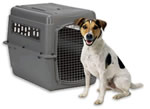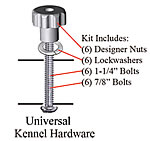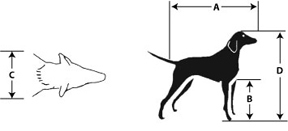Airline Pet Cargo Crate Requirements
 The rules regarding approved types of containers for cats, dogs, ferrets and birds flying in cabin and as cargo were created by the International Air Transport Association (IATA) and, for the most part, have been accepted by the world’s airlines.
The rules regarding approved types of containers for cats, dogs, ferrets and birds flying in cabin and as cargo were created by the International Air Transport Association (IATA) and, for the most part, have been accepted by the world’s airlines.
Pets traveling as cargo
Whether your pet is flying as checked baggage or cargo, it will travel in a temperature controlled and pressurized compartment right under the cabin. Most airlines flying larger aircraft (not commuter planes) accept live animals as cargo and have made special provisions for their handling. Exceptions to this are Southwest, AirTran, JetBlue, Frontier, Virgin America, and those airlines that do not accept pets in the cargo hold.
Requirements for Pet Cargo Crates
Your pet must travel in an IATA compliant pet crate and meet certain other requirements depending on the airline. It is considered best to have only one animal per container, but the IATA rules state that two animals can share the same container if the animals are under 14kg (30lbs) and are of the same species and compatible. It is up to the airline to set their own rules and most of them do.
We recommend these pet crates made by PetMate as they meet all of the standards for pets traveling as air cargo or checked baggage. They are one of the safest commercial cargo crates on the market today.
Minimum Cargo Crate Requirements
- The pet crate must be large enough for your pet(s) to stand, turn around, and lie down comfortably. Brachycephalic breeds (snub nosed) will require one size larger than normal for most airlines that permit them to fly in cargo. See sizing instructions below.
- The crate must be made of fiberglass, metal, rigid plastics, weld metal mesh, solid wood or plywood (note that not all airlines will accept crates made of wood, e.g. Air France and KLM)
- The floor must be solid and leakproof.
- Handling space bars or handles must be present on the long side of the crate.
- The container door must have a secure, spring loaded, all around locking system with the pins extending at least 1.6 cm (5/8 in) beyond the horizontal extrusions above and below the door. Many airlines will also require that the door be further secured with cable ties at each corner. Doors must be constructed of heavy plastic, welded or cast metal strong enough so that a pet cannot bend them. (We recommend metal.) The door must be nose and paw proof so as not to injure your pet in any way.
- The crate should be should be sturdy in design and not collapsible. Roof should be solid but can have ventilation as long as the strength of the roof is not comprimised. (We do not recommend crates with doors on the top.)
 Although this is not an IATA requirement, many airlines are now requiring steel crate hardware instead of plastic fasteners. We would recommend that you use this hardware on your pet’s crate to be sure there will be no problems. Also, many airlines require cable ties in the corners of the crate. Plastic clips are not recommended. All hardware and fasteners must be in place.
Although this is not an IATA requirement, many airlines are now requiring steel crate hardware instead of plastic fasteners. We would recommend that you use this hardware on your pet’s crate to be sure there will be no problems. Also, many airlines require cable ties in the corners of the crate. Plastic clips are not recommended. All hardware and fasteners must be in place.- Both water and food bowls must be attached to the inside of the front door and be refillable from the outside of the crate without opening the door. Small funnels attached to the door by cable ties make it easier for airport handlers to refill water bowls. Food can be attached to the top of the crate in a plastic bag.
- The container must have ventilation on a minimum of two sides (domestic flights) and 4 sides (international flights). The openings must be a minimum of 1 in(2.5 cm) over the upper two thirds of the opposite end and the remaining two sides, at a distance of 4 in (10 cm) from centre to centre of each opening. The total ventilated area must be at least 16% of the total surface of the four sides. Additional holes on the roof or sides are permitted as long as they do not affect the strength of the crate. The ventillation holes must not be taped over or blocked in any way.
- The container must have LIVE ANIMAL STICKERS on the top and sides in letters at least one inch tall as well as directional stickers. Also, there must be a sticker adhered to the top of the crate called a Shipper’s Declaration stating when your pet was last watered and fed. These stickers can be found in our Accessory Kits.
- NO WHEELS. If the container has wheels, they should be removed or taped securely so that the kennel cannot roll.
- The container must be identified with you pet’s name and owner’s contact information. The best way to do this is to attach your pet’s information to the outside of the crate with duct tape or other sturdy tape.
- Forklift spacers must be provided when the pet exceeds 132 lbs. (60kg)
- Click here for more information on pet cargo crates. Here are examples of IATA compliant pet cargo crates.
Extra Crate Recommendations
- Attach a leash and collar to the outside of the kennel. (put in a plastic bag and tape)
- Tape or print your pet’s name on the outside of the crate as well as the owner’s name, address and cell phone number.
- Include a pet pad or shredded newspaper. This is a requirement of many airlines.
- Include an unwashed t-shirt with your scent on it. This will provide comfort to your pet.
- Tape the original health certificate and any other papers required by your destintion country to the top of the crate in a plastic bag marked “DO NOT REMOVE! ORIGINAL DOCUMENTS”
- Do not include any hard toys or objects that could bounce around and injure your pet.
Sizing Your Pet Crate
This is a crucial step in ensuring your pet’s safety and comfort and can make the difference between being accepted or refused by your airline. Measure your pet according to the chart below for domestic flights. See below for international requirements. Compare your findings with the interior measurements of the crate.

A= length of animal from nose to root of tail
B = height from ground to elbow joint
C = width across shoulders
D = height of animal in standing position (top of head for pets with non-erect ears – from tip of ears for pets with erect ears)
The length of the kennel must be equal to A + 1/2 B. (domestic flights) A+B (International flights)
The width of the kennel must be equal to Cx2 (domestic flights) (C+1 in) x 2 (international flights)
The height of the kennel (top flat or arched) must be equal to D (domestic flights) D+3 in (international flights).
Traveling Internationally?
If you are traveling internationally, the length of the crate will equal A+B and the height of the crate will equal D+3 in for pets with non-erect ears and from tip of ears + 3 in for pets with erect ears.
